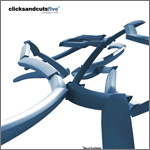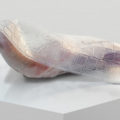(May 2010) After lying dormant for several years Mille Plateaux makes and an unexpected but welcome return to the fray. Following an ill-fated attempt to resurrect the label in 2004 finally fizzled out in 2006 it seemed the label was gone for good until news started to circulate that the label would be re-launching again in mid-2010. This time with a more focused and defined plan of action, Mille Plateaux returns with several new artist releases and a new volume in the popular Clicks & Cuts series entitled Clicks & Cuts 5: Paradigm Shift which revisits a genre the label originally championed with three stellar big name compilations between 2000 and 2002.
::..:::…..:..::….:::::..:::..:::::::……:::…::.:::….::::..:..:::…::…….:::::
 Ametsub :: The Nothings of the North (Listen / Purchase)
Ametsub :: The Nothings of the North (Listen / Purchase)
Mysterious Japanese artist Ametsub released Linear Cryptics, his debut album, for the Tokyo-based label Progressive Form in 2006. After releasing a split mini-album appropriately titled Jimanica x Ametsub in 2007, he released his sophomore album The Nothings of the North early in 2009 as a joint venture between Tokyo’s Progressive Form and Third Ear labels. The Nothings of the North has now been licensed to the revitalised German label Mille Plateaux for international release.
Having already gained a fan in the form of Japan’s Ryuichi Sakamoto, Ametsub continues to produce music that mixes experimental clicks and cuts techniques with gentle ambient textures and his own piano playing. Often taking short cut up snippets of sampled or recorded sound and rearranging them into a jittery, spluttering new structure, Ametsub’s music takes a mellow jazzy sound, dissembles it and then reconstructs it into something new. The smooth sounds are still there but his piano adds an air of tension and crisp metallic shards of electronic debris push it in a new experimental direction. Carefully arranging and looping fragments of piano, synth and voice into a strange new ambient glitch music for the electronic age, Ametsub’s music blips, bloops and clicks manically like it was created by machines. Occasionally increasing in urgency and tension with loud outbursts, The Nothings of the North generally errs on the side of ambient texture such as the building anxiety found in “Peaks Far Afield” or the serene cascading tones of “Time for Trees” which cleverly uses its crisp glitch tones as a percussive accompaniment. Gently swaying between cinematic tension and lush ambience interspersed with forays into creative experimentation, The Nothings of the North is an engaging trip into the world of glitchy electronics that draws on a wide range of musical influences throughout its duration.
::..:::…..:..::….:::::..:::..:::::::……:::…::.:::….::::..:..:::…::…….:::::
 Kabutogani :: Bektop (Listen / Purchase)
Kabutogani :: Bektop (Listen / Purchase)
Almost as mysterious is French artist Jerome B recording under the pseudonym Kabutogani – the Japanese word for horseshoe crab – who releases Bektop, his fourth album since his debut in 2001. Although he remains relatively anonymous his music fits nicely into the clicks and cuts genre championed by the original Mille Plateaux label before its untimely demise. Now that it is back the label is revisiting the clicks and cuts sound to see how it has developed and Kabutogani is one of the artists chosen to represent that progression.
The difference in style between Kabutogani and Ametsub is almost immediate; his sound is deeper and more minimal but not devoid of rhythm or melody. Flicking between buzzing electronics and the tiniest of micro-sounds Bektop is a cleverly constructed balance of deep tonal rhythmic textures and microscopic melodic fragments. In some ways it is clinical and precise but in others it is cinematic, absorbing and addictively rhythmic. Nothing about its construction is harsh, noisy or loud, everything is carefully considered and constructed to be deep and intricate. Everything about this album is subtle; tracks such as “The Green Dome”, “SIGINT,” “Production Peripherals” and “Kuril Probe” heave with deep rhythmic bass tones yet “Book Gills” is more subdued and surprisingly poignant for this type of album. Elsewhere on the album he heads down an entirely more experimental path with dense and more abstract sound structures.
::..:::…..:..::….:::::..:::..:::::::……:::…::.:::….::::..:..:::…::…….:::::
 V/A :: Clicks & Cuts 5: Paradigm Shift (Listen / Purchase)
V/A :: Clicks & Cuts 5: Paradigm Shift (Listen / Purchase)
Perhaps the most anticipated of the initial batch of releases from the newly resurrected Mille Plateaux label is the return of the genre defining Clicks & Cuts compilation series with a new instalment entitled Clicks & Cuts 5: Paradigm Shift. This series, and particularly the first three landmark volumes, sees a welcome return of a musical form championed by the original label in the last few years before its demise. As the title suggests, the fifth volume in the series picks up where the previous one left off, revisiting the genre to see how it has moved on since the last compilation appeared in 2004.
Comprised of a collection of tracks from a plethora of newcomers, what quickly becomes apparent is that the clicks and cuts sound has developed in a number of (although perhaps only subtly) different directions since the previous volume with tracks representing the divergence in styles in the intervening time period. Ametsub and Kabutogani both contribute tracks from their respective new albums, both of which are being released (amongst others) to launch the new label.
Opening with Scattertape’s “Shelving a Tempered String” intro, the compilation begins with what can only be described, perhaps appropriately, as an orchestra tuning up fed through several digital effects filters accompanied by the stylised blip of a heart monitor. A bassy loop pulsates as digital interference buzzes and heaves around Aoki Takamasa’s “RN4-09” while Sifa Dias follows suit with “Eitec Aa,” adding sparkling melodies as glitchy atmospheric clicks whir discretely below. More orthodox is Loom’s catchy “Isolex 03” which features smooth breaks backed with echoed synth tones that give it a futuristic edge, the music alternating between crisp breaks and spacial ambience. Following in Loom’s footsteps is “Ecoli” by Marow who slowly builds on looped sounds to create a warm hypnotic resonance with a touch of tension and anxiety. Nicolaus follows the same path as Marow and Loom with “Inner” but tones the mood down still further to a low drone with gentle train-like rhythms edged with glitchy crackles. Klive takes Sifa Dias’ melodic tendencies with “Sweaty Psalms” and mangles them to create an experimental soundtrack soaked with nightmarish tension and edgy anxiety. Gultskra & Artikler’s “w” creates a similar air of unease with strange disorientating noises and creeping atmospheres although this time the mood is one of sinister dark ambience. Heading down a slightly different path to create a similar effect is Yu Miyashita with “Scrypt;” echoed bursts of bass toll ominously accompanied by jangly chimes as if calling from the beyond. Alinoe’s “Il (Outro)” is a short warm ambient track that provides a gentle ‘calm before the storm’ interlude before the sonic assault that is Iodsb’s “Eve.”
Moving on to the more experimental and abstract selection of tracks, “Object 02” by Wyatt Keusch starts proceedings with clinical rapid-fire beats, metallic rhythms and glitchy abstract tendencies. Kiyo’s “Bear in Warm-Noiz” takes smooth breaks with an underlying layer of subtle cinematic tension and adds some strange metallic melodies that distract from what had potential to be an intriguing track. Perhaps the most abstract track on the compilation is Iodsb’s “Eve” which is a noisy onslaught of increasingly abstract scattergun digital beats paired with stuttering glitchy madness. Rimacona’s “Messa” is perhaps the most unusual track on the compilation. It takes a foreign language female vocalist accompanied by piano and adds discrete glitch beats and metallic percussion to close the compilation. It is a surprise choice to end things with and probably not what most listeners will expect.
It is a welcome return for the Mille Plateaux label and they intend to make a splash with a slew of new releases hitting around the same time with more planned to follow. Not only is the label itself emerging phoenix-like from the ashes once more but there will be several new sub-labels launched to cater for various sub-genres in an attempt to theme releases to particular labels. The Ametsub and Kabutogani albums are a solid start and Clicks & Cuts 5 revisits a genre explored through the original compilation series and looks at how, or indeed if, it has evolved since.
::..:::…..:..::….:::::..:::..:::::::……:::…::.:::….::::..:..:::…::…….:::::
A lot planning has gone into the re-launch of what was a consistently popular and respected label. Whether it will be able to return to its former glory in a radically changed music environment is yet to be seen. Some careful thought has gone in to the resurrection of Mille Plateaux and there is a lot of new music and a lot of new artists to explore before any of us will find the answer. They have made a good start and let’s hope they continue to build on it.
All three releases are out now on Mille Plateaux. [Listen / Purchase]
Read the April 2010 Mille Plateaux profile here.

























